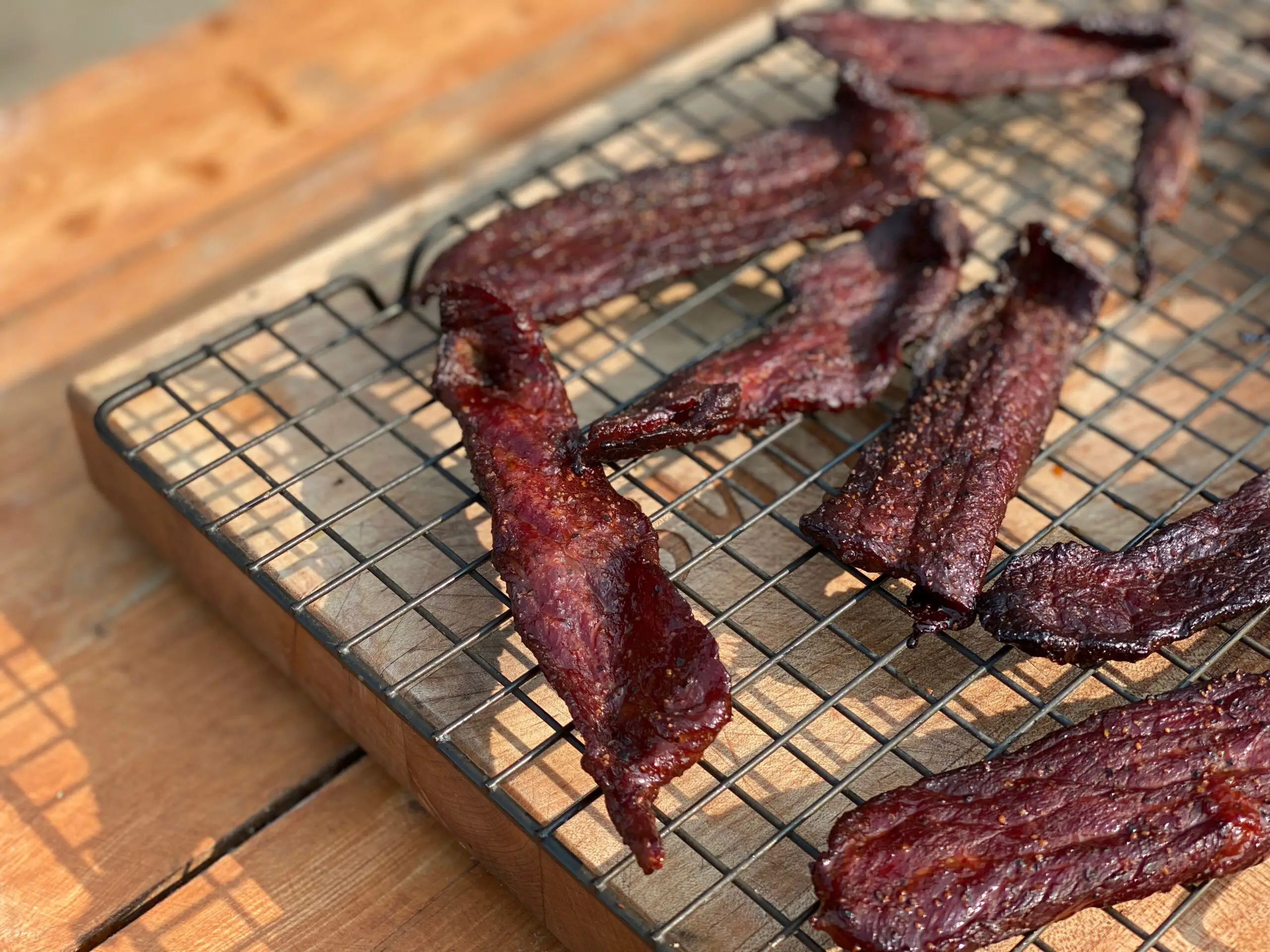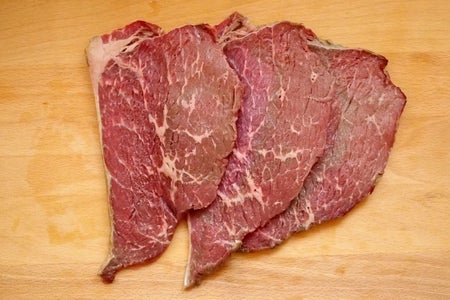Beef jerky is a tasty, protein-packed snack that’s fun to make at home. Getting the right temperature when smoking jerky is key to ensuring it turns out with the perfect texture – dried but not overly crispy, chewy but not tough. So what’s the ideal temperature range for smoking jerky? Read on for a complete guide.
Why Temperature Matters
Temperature plays a critical role in properly dehydrating and preserving meat when making beef jerky. If the temperature is too low, the meat won’t fully dry out, creating conditions where bacteria can grow and spoil the jerky. Go too hot and you’ll end up with jerky that’s dried out, brittle and lacking in flavor.
The right temperature allows moisture to evacuate slowly without actually cooking the meat. This concentrates the natural flavors while still leaving it chewy and flexible. Controlling temperature also ensures the meat reaches the Food Safety and Inspection Service (FSIS) recommended internal temperature of 160°F for safety.
Best Temperature for Smoking Jerky
The ideal temperature range for smoking beef jerky is 160-180°F. At around 160-165°F, the meat will safely dry without cooking too quickly. Temperatures up to 180°F are still suitable, as long as ventilation is adequate to allow moisture to escape.
Many experts recommend sticking to the lower end of this range, around 160-170°F, for the best texture and flavor. The jerky may take a little longer to fully dry, but the payoff is jerky that is tender and robust.
Going above 180°F risks the meat drying out too quickly before the moisture can dissipate You may end up with jerky that is crispy but also tough.
Tips for Managing Temperature
Controlling temperature when smoking jerky requires a little finesse. Here are some tips:
-
Use an electric smoker if possible, as these allow you to dial in a precise temperature.
-
Open vents to increase airflow if the temperature creeps above 180°F.
-
Don’t open the smoker too frequently as this will lower the internal temperature.
-
Use a meat thermometer to monitor doneness; stop when jerky reaches an internal temp of 160°F.
-
If using a charcoal or wood smoker, try moving coals to one side and keeping the jerky on the cooler side.
-
Adjust dampers on a charcoal smoker to control air flow and temperature.
-
Add a water pan or soak wood chips to create a humid environment.
Drying Times at Various Temperatures
Drying times will vary based on the temperature you are smoking at, as well as the thickness of the meat. Here are some general timelines:
-
160-170°F – approximately 4-6 hours
-
175-180°F – approximately 3-5 hours
-
185-190°F – approximately 2-4 hours
-
200°F+ – approximately 1-3 hours
As a rule of thumb, temperatures on the lower end of the range will produce jerky with the ideal texture but take longer, while higher temperatures speed the drying time but can compromise quality if you aren’t careful.
Always check jerky periodically as it smokes. Bend a piece in half – it should crack but not break when ready.
Doneness Tests Beyond Temperature
While a 160°F internal temperature is recommended for safety, you can also test for doneness using these visual cues:
-
The meat has darkened and developed a leathery look
-
Thicker pieces crack or break when bent instead of folding
-
The jerky is dry and firm to the touch with no moist spots
-
A toothpick inserted into a piece comes out clean
-
The jerky is no longer sticky or tacky
Trust your senses – the jerky should look, feel and taste properly dried when it’s ready. The texture will vary based on personal preference. Some like jerky crispy while others prefer a chewy consistency.
Storing Jerky After Smoking
Proper storage is important once your jerky is smoked to prevent spoilage. Here are some tips:
-
Let jerky cool completely before storing.
-
Store in an airtight container or sealed bags.
-
Refrigerate for up to 2 weeks.
-
For longer shelf life, freeze jerky for up to 2-3 months.
-
If storing at room temp, consume within 1 week.
Following the right jerky smoking and storing methods will allow you to enjoy delicious home smoked jerky anytime! Getting the temperature just right is the key to safe, tender and flavorful jerky.

Introduction: Smoked Beef Jerky

For a quick and tasty snack, nothing beats beef jerky! You can buy jerky at the store, but it’s really easy to make your own on your smoker, and you can get any flavor you want!
It’s so much fun to have an outdoor smoker, and your friends will be begging you to have them over again as soon as they try your smoked foods. Any type of charcoal or electric backyard smoker will work. If youre unsure, check out this part of my Smoker Lesson to learn more.
Heres what well need for this lesson:
This instructable goes with the meat smoking lesson and assumes you know how smokers work in a basic way. Check out the smoking lesson to learn about smokers outside and the difference between smoking hot and smoking cold. For making beef jerky well be cold smoking.
Cold smoking is done at a low temperature (under 120°F (49°C)). Some people don’t like cold smoking meat because the temperature doesn’t rise above 140°F (60°C), which is what’s needed to kill any bacteria on the meat’s surface. But if you do it right, the smoker can be used to make beef jerky that will dry the meat all the way through. Dehydrated food has its moisture removed, and harmful bacteria cant efficiently contact or react with dry food.
Some other great foods to cook on a smoker are pulled beef, homemade sausages, and even smoked almonds. If you like this smoker recipe, click here.
Step 1: Meat Preparation

Fat makes jerky go bad faster because it can’t be dried as well as meat. That’s why jerky is very lean and has almost no fat.
You can make jerky out of any lean cut of beef, but flank steak that you find at your butcher is already prepared nice and thin, so thats what I use. Id advise against pork and wild game jerky until youre comfortable with the process, since the risk of trichinosis is a thing.
There may be some fat on your flank steak, even though it is already a lean cut. Use a sharp knife to cut off as much fat as you can from each cutlet.
Theres debate on whether to cut the steak strips with the grain or against it. Cuts with the grain will produce longer strips, but cuts against the grain are easier to chew. I suggest trying both to determine your personal preference.
You want a thin cut of steak with almost no fat. Next the beef needs to be cut into strips. It’s up to you how wide the strips should be, but I would keep them below 1/2″ so they dry faster.
Before we can smoke the steak well need a marinade. And just like with the smoked almonds, there is no wrong way to mix them; it all depends on your taste. Heres a basic jerky marinade:
Smoked Beef Jerky:
- Flank steak: about 2 lbs
- Honey: 1 tbps
- Garlic powder: 1 tbsp
- Soy sauce: 3/4 cup
- Worcestershire sauce: 3/4 cup
- Salt + pepper: a generous amount of each
I like to put all the meat cuts and the seasonings in a large plastic bag that can be closed again and again. Then I seal the bag and coat the steaks with the mixture. Place in refrigerator and leave to marinate overnight.
You can smoke your steak strips the next morning after letting them sit for a few hours.
What temperature do you smoke deer jerky at?
FAQ
What temperature do you smoke jerky at and for how long?
Is 180 too hot for jerky?
How long to smoke jerky at 165?
Can you smoke beef jerky at 180?
